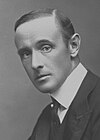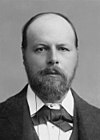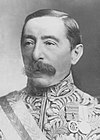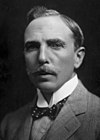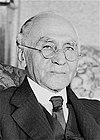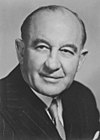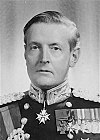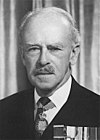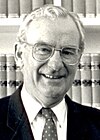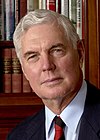Background
For the first two decades after federation, governors-general were selected solely by the British government. The monarch was consulted on the decision into the 1930s. The first four governors-general were peers; Sir Ronald Munro Ferguson (appointed 1914) was the first commoner to hold the position, although he was also later elevated to the peerage. In 1920, Billy Hughes became the first prime minister to be consulted over the governor-generalship. Stanley Bruce (1925) and Joseph Lyons (1935) either asked for or were given a list of suitable candidates to choose from.
James Scullin (1930) became the first prime minister of Australia to exercise complete discretion in the appointment; his nomination of Sir Isaac Isaacs made Australia the first Dominion to have a native-born governor-general. In 1945, John Curtin nominated Prince Henry, Duke of Gloucester, to the post – the first and only royal officeholder to take up the post; however, in October 1938 Prince George, Duke of Kent had been announced as the successor to Lord Gowrie with effect from November 1939, [1] [2] but on 11 September 1939, owing to the outbreak of the Second World War, the Duke's appointment was postponed. It never eventuated, instead Lord Gowrie continued his incumbency until 1945, creating a still-unsurpassed record term of over 9 years. [3] A second Australian (William McKell) was appointed in 1947; he was followed by three more Britons, each chosen by Sir Robert Menzies. Menzies's fourth nomination was Richard Casey, who took office in 1965; he and all subsequent governors-general have been Australian citizens. All states except South Australia and Tasmania have provided at least one appointee. The first female governor-general, Quentin Bryce, took office in 2008.
On 16 December 2018, prime minister Scott Morrison announced that the next governor-general would be General David Hurley, then-governor of New South Wales. To provide continuity through general elections both federally and in New South Wales, Hurley succeeded General Sir Peter Cosgrove, who had planned to retire in March 2019, on 1 July 2019. [4] [5]
On 3 April 2024, prime minister Anthony Albanese announced that General Hurley would be succeeded on 1 July 2024 by businesswoman Sam Mostyn, the second woman to be governor-general.

The governor-general of Australia is the representative of the monarch of Australia, currently King Charles III, and performs many constitutional, ceremonial and community roles in the Australian political system. When performing these roles, the governor-general acts independently and is not the King's delegate or agent. The current governor-general is David Hurley, having been appointed on 1 July 2019. Samantha Mostyn has been chosen by Prime Minister Anthony Albanese to be the next governor-general, beginning 1 July 2024.

The prime minister of Australia is the head of government of the Commonwealth of Australia. The prime minister chairs the Cabinet and thus heads the federal executive government. Under the principles of responsible government, the prime minister is both a member and responsible to Parliament. The current prime minister is Anthony Albanese of the Australian Labor Party, who assumed the office on 23 May 2022.
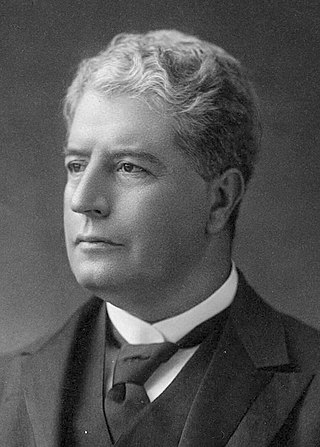
Sir Edmund "Toby" Barton was an Australian statesman, barrister and jurist who served as the first prime minister of Australia from 1901 to 1903. He held office as the leader of the Protectionist Party, before resigning in 1903 to become a founding member of the High Court of Australia, on which he served until his death. He was highly regarded as one of the leaders and founding fathers of the Federation movement and for his work in drafting and later interpreting the Constitution of Australia and early federal laws.

Government House is the official residence of the governor-general of Australia. It is located in the suburb of Yarralumla, in the City of Canberra, in the Australian Capital Territory. The house is set amid 54 hectares of parkland. The house and associated grounds were added to the Commonwealth Heritage List on 22 June 2004.

William George Hayden was an Australian politician who served as the 21st governor-general of Australia from 1989 to 1996. He was Leader of the Labor Party and Leader of the Opposition from 1977 to 1983, and served as Minister for Foreign Affairs and Trade from 1983 to 1988 under Bob Hawke and as Treasurer of Australia in 1975 under Gough Whitlam.

John Adrian Louis Hope, 1st Marquess of Linlithgow, 7th Earl of Hopetoun, was a British aristocrat and statesman who served as the first governor-general of Australia, in office from 1901 to 1902. He was previously Governor of Victoria from 1889 to 1895.

Hallam Tennyson, 2nd Baron Tennyson, was a British aristocrat who served as the second governor-general of Australia, in office from 1903 to 1904. He was previously Governor of South Australia from 1899 to 1902.

Henry Stafford Northcote, 1st Baron Northcote, was a British Conservative politician who served as the third governor-general of Australia, in office from 1904 to 1908. He was previously the governor of Bombay from 1900 to 1903, as well as a government minister under Lord Salisbury.

Sir John Lawrence Baird of Urie, 1st Viscount Stonehaven, 1st Baron Stonehaven, 2nd Baronet, 3rd of Ury, was a British politician who served as the eighth Governor-General of Australia, in office from 1925 to 1930. He had previously been a government minister under David Lloyd George, Bonar Law, and Stanley Baldwin.
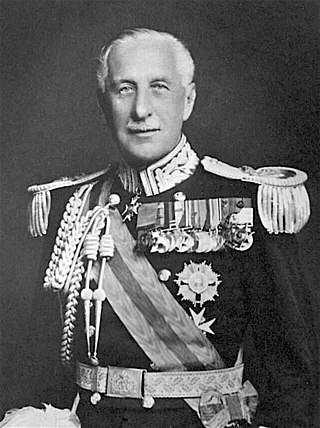
Brigadier General Alexander Gore Arkwright Hore-Ruthven, 1st Earl of Gowrie, was a British Army officer who served as the 10th Governor-General of Australia, in office from 1936 to 1945. He was previously Governor of South Australia (1928–1934) and Governor of New South Wales (1935–1936).

Sir William John McKell, was an Australian politician who served as the 12th Governor-General of Australia, in office from 1947 to 1953. He had previously been Premier of New South Wales from 1941 to 1947, as leader of the Labor Party.
The title Administrator of the government (Administrator) has several uses in Australia.

The attorney-general of Australia (AG) is the minister of the Commonwealth of Australia who is the chief law officer of the government. They are charged with overseeing the national legal affairs and public security as the head of the Attorney-General’s Department. The current attorney-general is Mark Dreyfus, who was chosen by prime minister Anthony Albanese on June 2022 following the 2022 federal election. By convention, the attorney-general is a lawyer.

Arthur Herbert Tennyson Somers-Cocks, 6th Baron Somers,, was a British Army officer who was the 16th Governor of Victoria, from 1926 to 1931 and Administrator of Australia in 1930-31. He had a long involvement with the Boy Scout Movement and became the Boy Scouts Association's Chief Scout of the British Empire from 1942 until his death.
The Hopetoun Blunder was a political event immediately prior to the Federation of the British colonies in Australia.
Peers of the Realm have been associated with Australia since early in its history as a British settlement. Many peers served as governors of the Australian colonies, and in the days when the practice of appointing British governors-general was current, the great majority were peers.
Australia is a constitutional monarchy whose Sovereign also serves as Monarch of the United Kingdom, New Zealand, Canada and eleven other former dependencies of the United Kingdom including Papua New Guinea, which was formerly a dependency of Australia. These countries operate as independent nations, and are known as Commonwealth realms. The history of the Australian monarchy has involved a shifting relationship with both the monarch and also the British government.
The viceregal consort of Australia generally assists the governor-general in welcoming ambassadors and their spouses, and in performing their other official duties. The governor-general's spouse traditionally participates in celebratory occasions, attends functions and, as a patron of various voluntary associations, works to promote the activities of those associations. None of the activities have any official status. The current spouse is Linda Hurley, wife of David Hurley.

The Barton government was the first federal executive government of the Commonwealth of Australia. It was led by Prime Minister Sir Edmund Barton, from 1 January 1901 until 24 September 1903, when Barton resigned to become one of the three founding judges of the High Court of Australia.

Richard Gavin Gardiner Casey, Baron Casey, was an Australian statesman who served as the 16th Governor-General of Australia, in office from 1965 to 1969. He was also a distinguished army officer, long-serving cabinet minister, Ambassador to the United States, member of Churchill's War Cabinet, and Governor of Bengal.

